Critical Analysis: Australian Healthcare System Financial Comparison
VerifiedAdded on 2022/11/18
|12
|2283
|283
Report
AI Summary
This report provides a critical analysis of the Australian healthcare system from a financial perspective, comparing and contrasting it with the healthcare systems of two other OECD member countries, specifically the United States and the United Kingdom. The analysis delves into the financial structures, performance measures, and key areas of efficiency and inefficiency within the Australian system. It examines how Australia fares in comparison to the OECD average across various parameters, including life expectancy, healthcare expenditure, and specific health indicators like obesity and hospital admission rates. The report highlights areas where Australia excels, such as universal healthcare access, and identifies areas needing improvement, such as addressing indigenous health issues and managing chronic diseases. It also provides recommendations for enhancing the Australian healthcare system's accessibility, efficiency, and financial sustainability, emphasizing the importance of addressing out-of-pocket costs, expanding dental care coverage, and reducing waiting times for elective procedures. The report draws on statistical data and research findings to support its conclusions and recommendations, offering valuable insights into the strengths and weaknesses of the Australian healthcare system in a global context. The report concludes by emphasizing the need for ongoing evaluation and adaptation to ensure the system continues to meet the evolving healthcare needs of the Australian population.
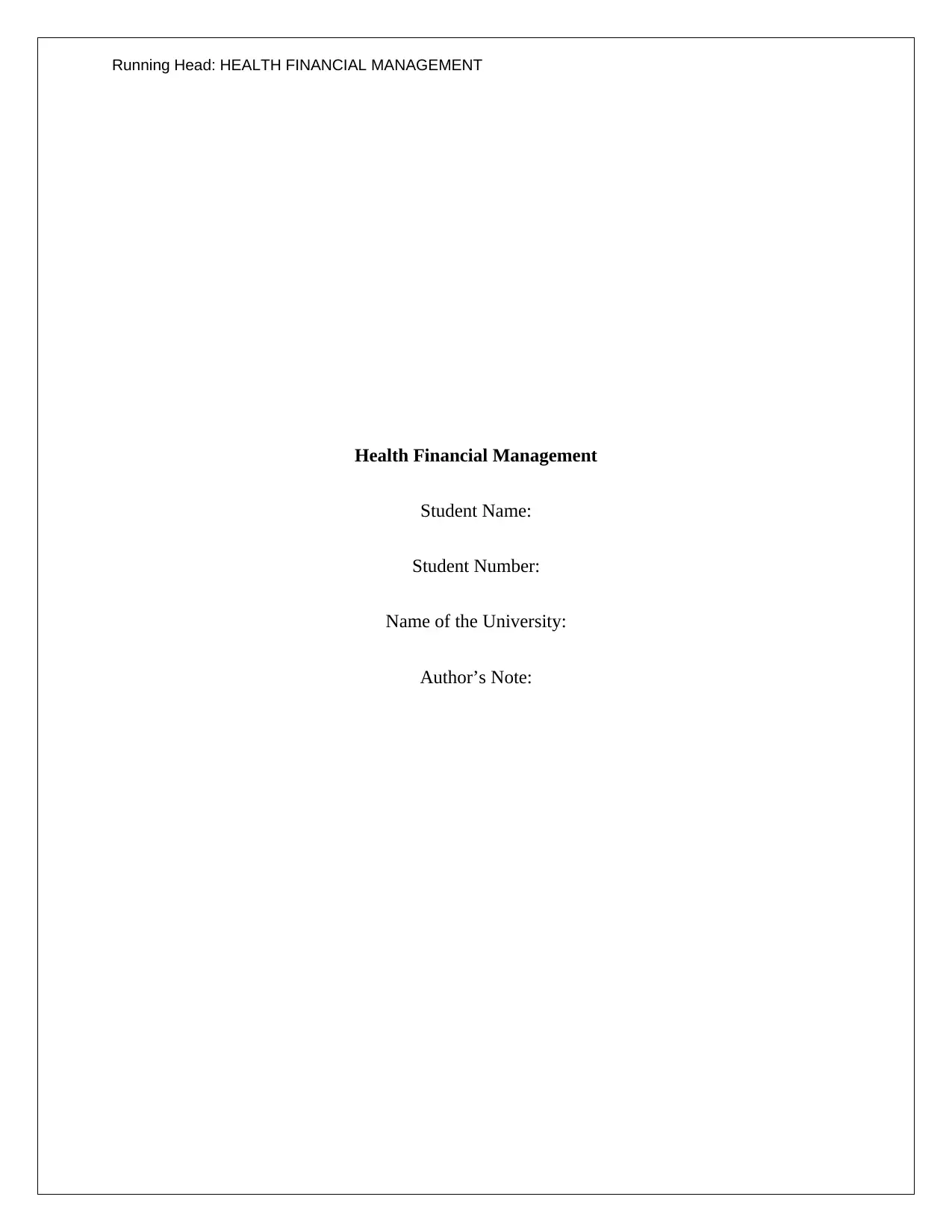
Running Head: HEALTH FINANCIAL MANAGEMENT
Health Financial Management
Student Name:
Student Number:
Name of the University:
Author’s Note:
Health Financial Management
Student Name:
Student Number:
Name of the University:
Author’s Note:
Paraphrase This Document
Need a fresh take? Get an instant paraphrase of this document with our AI Paraphraser
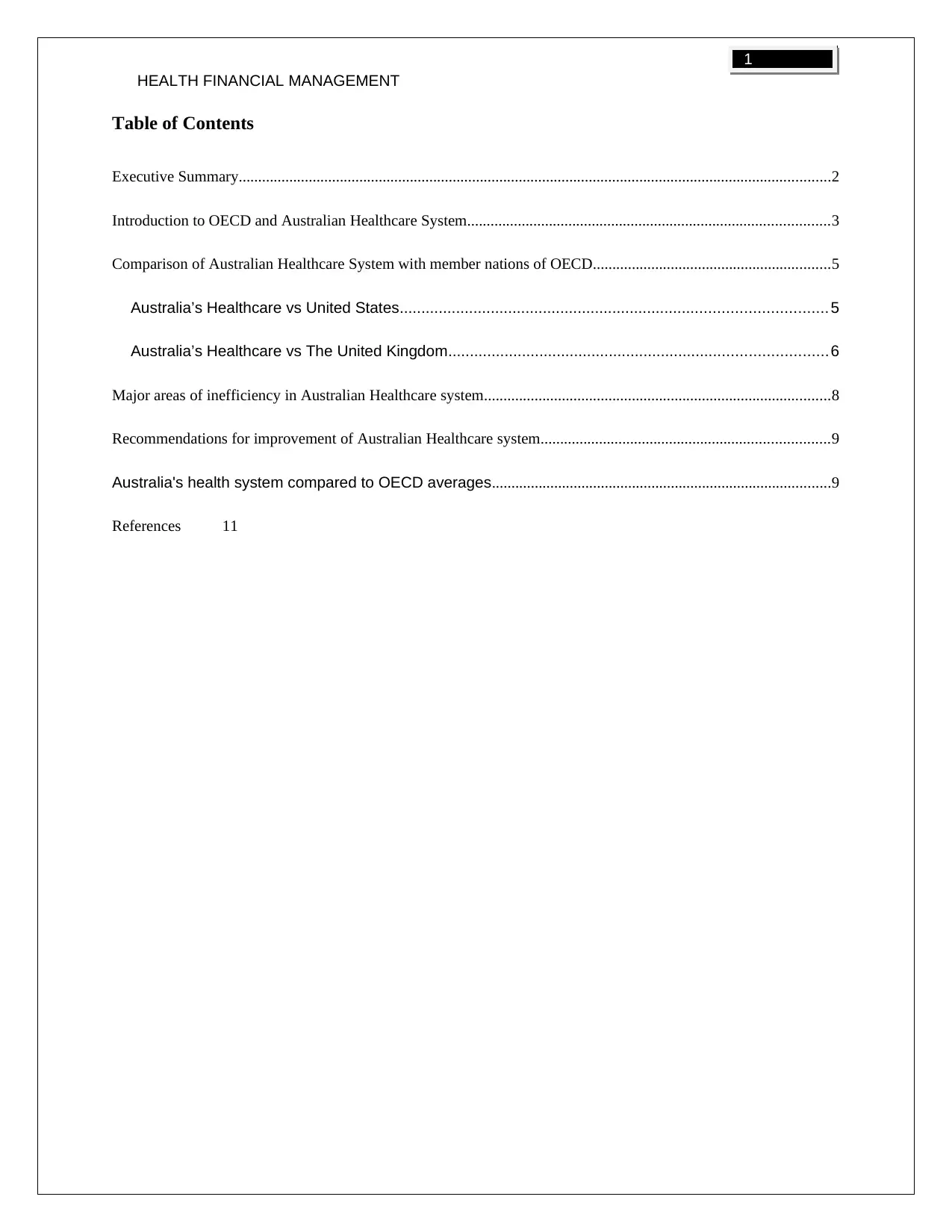
1
HEALTH FINANCIAL MANAGEMENT
Table of Contents
Executive Summary........................................................................................................................................................2
Introduction to OECD and Australian Healthcare System.............................................................................................3
Comparison of Australian Healthcare System with member nations of OECD.............................................................5
Australia’s Healthcare vs United States.................................................................................................. 5
Australia’s Healthcare vs The United Kingdom.......................................................................................6
Major areas of inefficiency in Australian Healthcare system.........................................................................................8
Recommendations for improvement of Australian Healthcare system..........................................................................9
Australia's health system compared to OECD averages.......................................................................................9
References 11
HEALTH FINANCIAL MANAGEMENT
Table of Contents
Executive Summary........................................................................................................................................................2
Introduction to OECD and Australian Healthcare System.............................................................................................3
Comparison of Australian Healthcare System with member nations of OECD.............................................................5
Australia’s Healthcare vs United States.................................................................................................. 5
Australia’s Healthcare vs The United Kingdom.......................................................................................6
Major areas of inefficiency in Australian Healthcare system.........................................................................................8
Recommendations for improvement of Australian Healthcare system..........................................................................9
Australia's health system compared to OECD averages.......................................................................................9
References 11
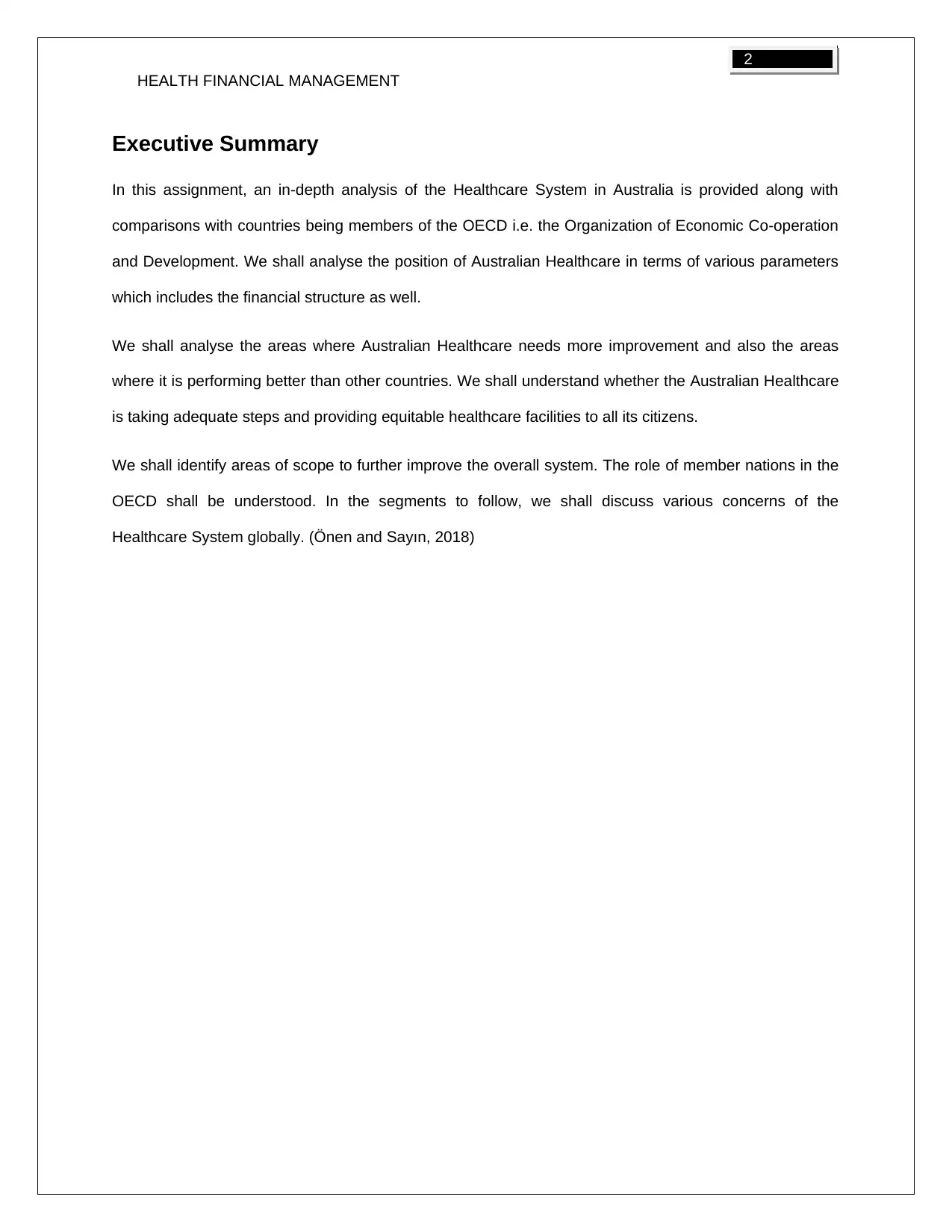
2
HEALTH FINANCIAL MANAGEMENT
Executive Summary
In this assignment, an in-depth analysis of the Healthcare System in Australia is provided along with
comparisons with countries being members of the OECD i.e. the Organization of Economic Co-operation
and Development. We shall analyse the position of Australian Healthcare in terms of various parameters
which includes the financial structure as well.
We shall analyse the areas where Australian Healthcare needs more improvement and also the areas
where it is performing better than other countries. We shall understand whether the Australian Healthcare
is taking adequate steps and providing equitable healthcare facilities to all its citizens.
We shall identify areas of scope to further improve the overall system. The role of member nations in the
OECD shall be understood. In the segments to follow, we shall discuss various concerns of the
Healthcare System globally. (Önen and Sayın, 2018)
HEALTH FINANCIAL MANAGEMENT
Executive Summary
In this assignment, an in-depth analysis of the Healthcare System in Australia is provided along with
comparisons with countries being members of the OECD i.e. the Organization of Economic Co-operation
and Development. We shall analyse the position of Australian Healthcare in terms of various parameters
which includes the financial structure as well.
We shall analyse the areas where Australian Healthcare needs more improvement and also the areas
where it is performing better than other countries. We shall understand whether the Australian Healthcare
is taking adequate steps and providing equitable healthcare facilities to all its citizens.
We shall identify areas of scope to further improve the overall system. The role of member nations in the
OECD shall be understood. In the segments to follow, we shall discuss various concerns of the
Healthcare System globally. (Önen and Sayın, 2018)
⊘ This is a preview!⊘
Do you want full access?
Subscribe today to unlock all pages.

Trusted by 1+ million students worldwide
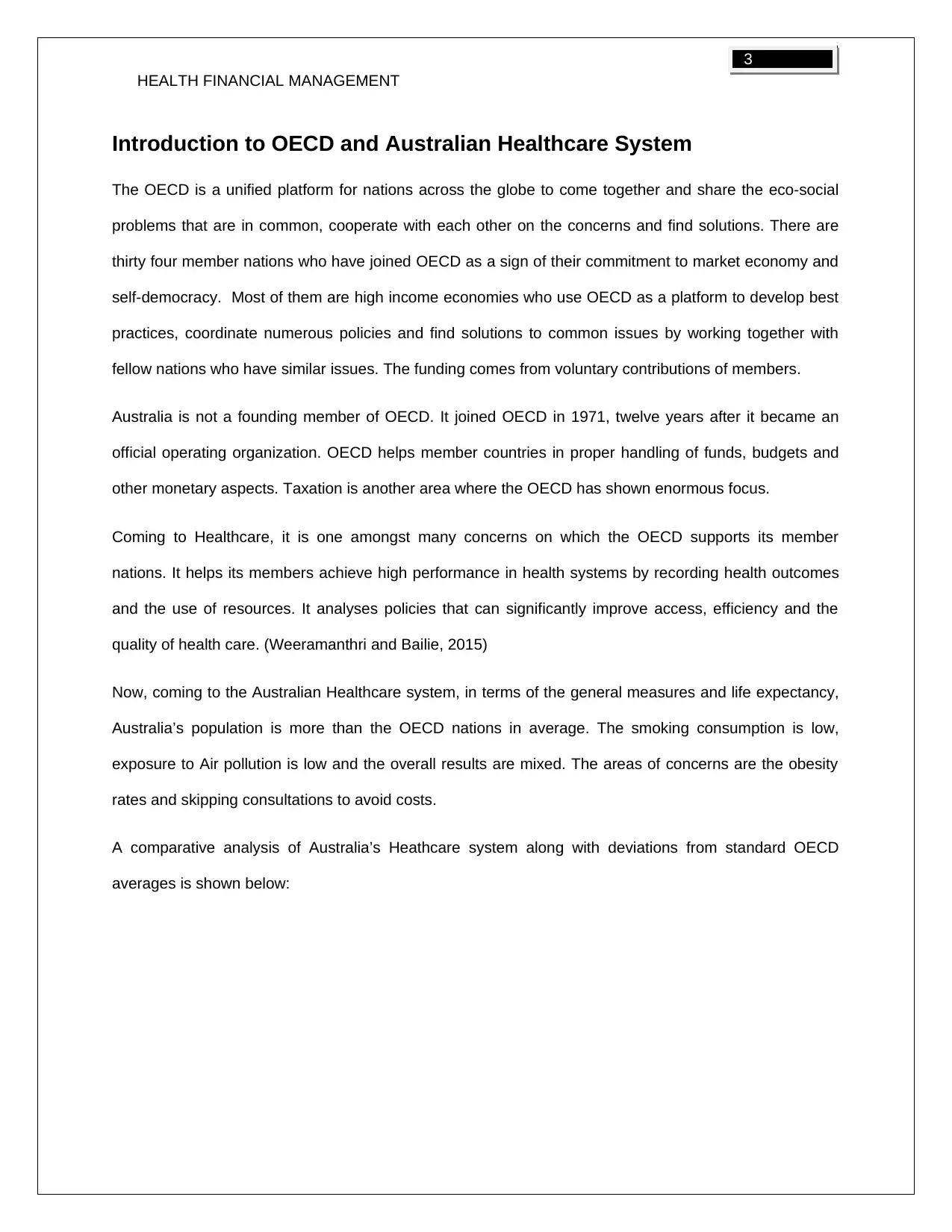
3
HEALTH FINANCIAL MANAGEMENT
Introduction to OECD and Australian Healthcare System
The OECD is a unified platform for nations across the globe to come together and share the eco-social
problems that are in common, cooperate with each other on the concerns and find solutions. There are
thirty four member nations who have joined OECD as a sign of their commitment to market economy and
self-democracy. Most of them are high income economies who use OECD as a platform to develop best
practices, coordinate numerous policies and find solutions to common issues by working together with
fellow nations who have similar issues. The funding comes from voluntary contributions of members.
Australia is not a founding member of OECD. It joined OECD in 1971, twelve years after it became an
official operating organization. OECD helps member countries in proper handling of funds, budgets and
other monetary aspects. Taxation is another area where the OECD has shown enormous focus.
Coming to Healthcare, it is one amongst many concerns on which the OECD supports its member
nations. It helps its members achieve high performance in health systems by recording health outcomes
and the use of resources. It analyses policies that can significantly improve access, efficiency and the
quality of health care. (Weeramanthri and Bailie, 2015)
Now, coming to the Australian Healthcare system, in terms of the general measures and life expectancy,
Australia’s population is more than the OECD nations in average. The smoking consumption is low,
exposure to Air pollution is low and the overall results are mixed. The areas of concerns are the obesity
rates and skipping consultations to avoid costs.
A comparative analysis of Australia’s Heathcare system along with deviations from standard OECD
averages is shown below:
HEALTH FINANCIAL MANAGEMENT
Introduction to OECD and Australian Healthcare System
The OECD is a unified platform for nations across the globe to come together and share the eco-social
problems that are in common, cooperate with each other on the concerns and find solutions. There are
thirty four member nations who have joined OECD as a sign of their commitment to market economy and
self-democracy. Most of them are high income economies who use OECD as a platform to develop best
practices, coordinate numerous policies and find solutions to common issues by working together with
fellow nations who have similar issues. The funding comes from voluntary contributions of members.
Australia is not a founding member of OECD. It joined OECD in 1971, twelve years after it became an
official operating organization. OECD helps member countries in proper handling of funds, budgets and
other monetary aspects. Taxation is another area where the OECD has shown enormous focus.
Coming to Healthcare, it is one amongst many concerns on which the OECD supports its member
nations. It helps its members achieve high performance in health systems by recording health outcomes
and the use of resources. It analyses policies that can significantly improve access, efficiency and the
quality of health care. (Weeramanthri and Bailie, 2015)
Now, coming to the Australian Healthcare system, in terms of the general measures and life expectancy,
Australia’s population is more than the OECD nations in average. The smoking consumption is low,
exposure to Air pollution is low and the overall results are mixed. The areas of concerns are the obesity
rates and skipping consultations to avoid costs.
A comparative analysis of Australia’s Heathcare system along with deviations from standard OECD
averages is shown below:
Paraphrase This Document
Need a fresh take? Get an instant paraphrase of this document with our AI Paraphraser
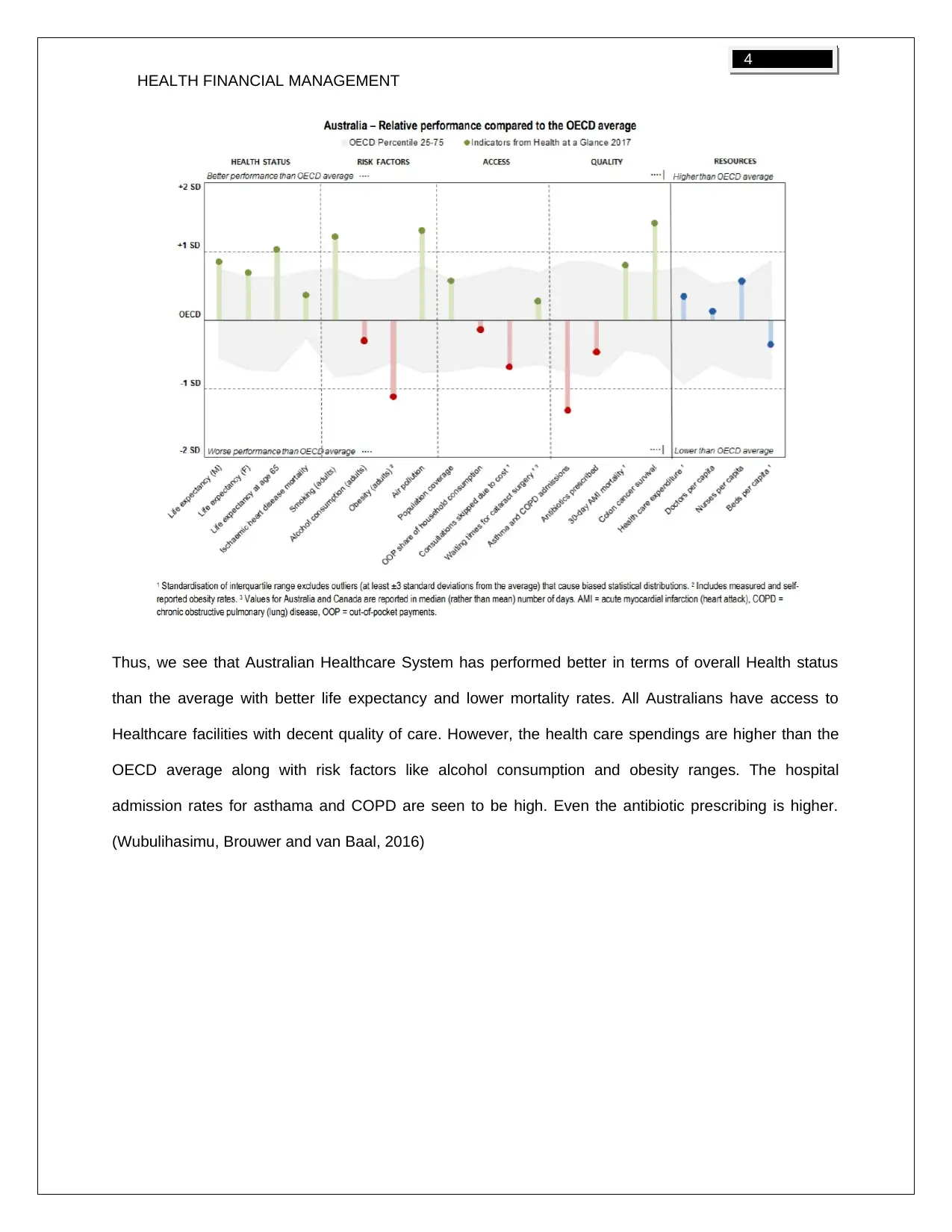
4
HEALTH FINANCIAL MANAGEMENT
Thus, we see that Australian Healthcare System has performed better in terms of overall Health status
than the average with better life expectancy and lower mortality rates. All Australians have access to
Healthcare facilities with decent quality of care. However, the health care spendings are higher than the
OECD average along with risk factors like alcohol consumption and obesity ranges. The hospital
admission rates for asthama and COPD are seen to be high. Even the antibiotic prescribing is higher.
(Wubulihasimu, Brouwer and van Baal, 2016)
HEALTH FINANCIAL MANAGEMENT
Thus, we see that Australian Healthcare System has performed better in terms of overall Health status
than the average with better life expectancy and lower mortality rates. All Australians have access to
Healthcare facilities with decent quality of care. However, the health care spendings are higher than the
OECD average along with risk factors like alcohol consumption and obesity ranges. The hospital
admission rates for asthama and COPD are seen to be high. Even the antibiotic prescribing is higher.
(Wubulihasimu, Brouwer and van Baal, 2016)
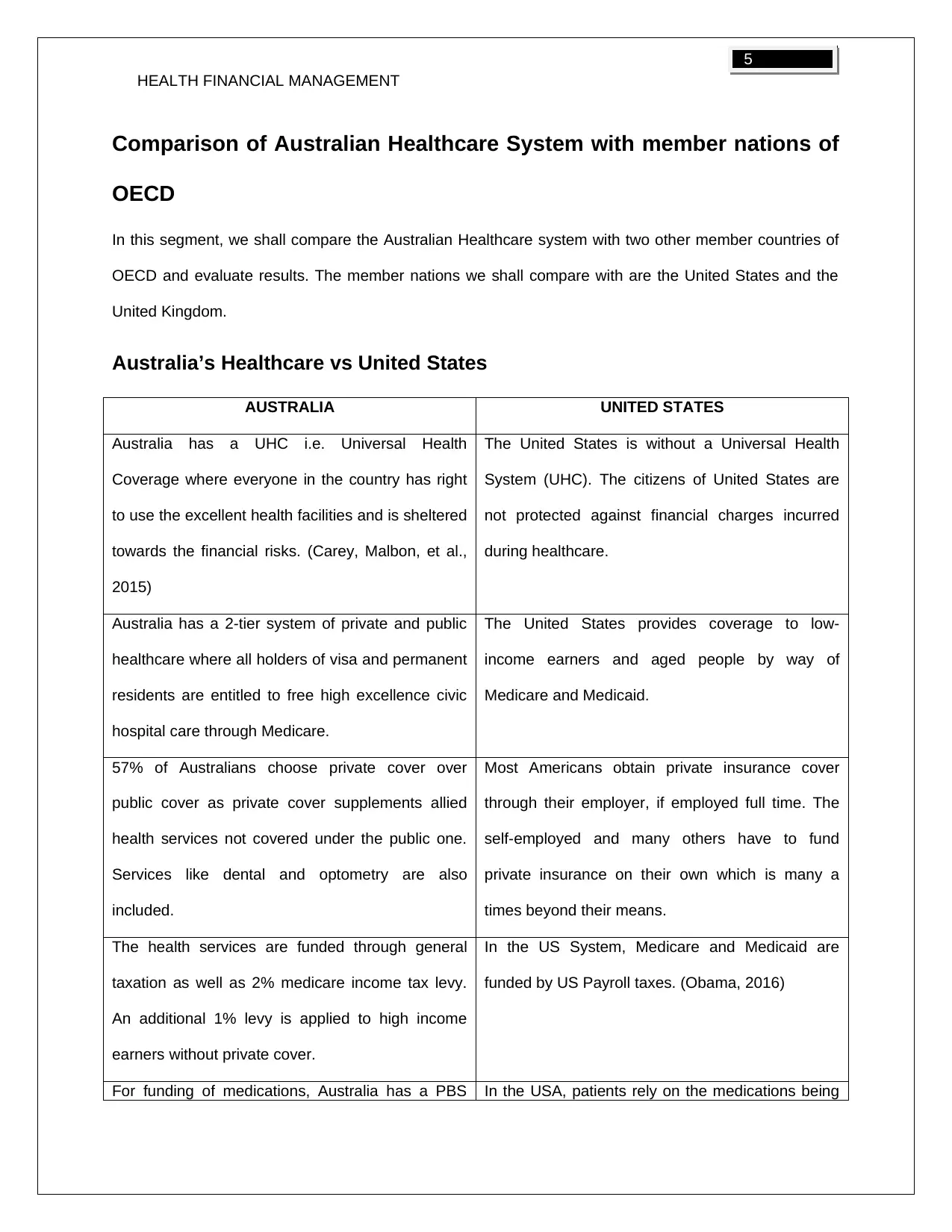
5
HEALTH FINANCIAL MANAGEMENT
Comparison of Australian Healthcare System with member nations of
OECD
In this segment, we shall compare the Australian Healthcare system with two other member countries of
OECD and evaluate results. The member nations we shall compare with are the United States and the
United Kingdom.
Australia’s Healthcare vs United States
AUSTRALIA UNITED STATES
Australia has a UHC i.e. Universal Health
Coverage where everyone in the country has right
to use the excellent health facilities and is sheltered
towards the financial risks. (Carey, Malbon, et al.,
2015)
The United States is without a Universal Health
System (UHC). The citizens of United States are
not protected against financial charges incurred
during healthcare.
Australia has a 2-tier system of private and public
healthcare where all holders of visa and permanent
residents are entitled to free high excellence civic
hospital care through Medicare.
The United States provides coverage to low-
income earners and aged people by way of
Medicare and Medicaid.
57% of Australians choose private cover over
public cover as private cover supplements allied
health services not covered under the public one.
Services like dental and optometry are also
included.
Most Americans obtain private insurance cover
through their employer, if employed full time. The
self-employed and many others have to fund
private insurance on their own which is many a
times beyond their means.
The health services are funded through general
taxation as well as 2% medicare income tax levy.
An additional 1% levy is applied to high income
earners without private cover.
In the US System, Medicare and Medicaid are
funded by US Payroll taxes. (Obama, 2016)
For funding of medications, Australia has a PBS In the USA, patients rely on the medications being
HEALTH FINANCIAL MANAGEMENT
Comparison of Australian Healthcare System with member nations of
OECD
In this segment, we shall compare the Australian Healthcare system with two other member countries of
OECD and evaluate results. The member nations we shall compare with are the United States and the
United Kingdom.
Australia’s Healthcare vs United States
AUSTRALIA UNITED STATES
Australia has a UHC i.e. Universal Health
Coverage where everyone in the country has right
to use the excellent health facilities and is sheltered
towards the financial risks. (Carey, Malbon, et al.,
2015)
The United States is without a Universal Health
System (UHC). The citizens of United States are
not protected against financial charges incurred
during healthcare.
Australia has a 2-tier system of private and public
healthcare where all holders of visa and permanent
residents are entitled to free high excellence civic
hospital care through Medicare.
The United States provides coverage to low-
income earners and aged people by way of
Medicare and Medicaid.
57% of Australians choose private cover over
public cover as private cover supplements allied
health services not covered under the public one.
Services like dental and optometry are also
included.
Most Americans obtain private insurance cover
through their employer, if employed full time. The
self-employed and many others have to fund
private insurance on their own which is many a
times beyond their means.
The health services are funded through general
taxation as well as 2% medicare income tax levy.
An additional 1% levy is applied to high income
earners without private cover.
In the US System, Medicare and Medicaid are
funded by US Payroll taxes. (Obama, 2016)
For funding of medications, Australia has a PBS In the USA, patients rely on the medications being
⊘ This is a preview!⊘
Do you want full access?
Subscribe today to unlock all pages.

Trusted by 1+ million students worldwide

6
HEALTH FINANCIAL MANAGEMENT
(Pharmaceutical Benefits Scheme) that caps out of
pocket costs for most medications.
covered by their private insurance.
The health care costs in Australia are not very high
and mostly affordable. Australia therefore has lower
healthcare costs and higher life expectancy.
(Gearhart, 2016)
The Healthcare costs in the US is much higher than
many nations because of higher service costs, lack
of controls and greater administrative costs. It
burns a hole in the patient’s pocket. USA therefore
has higher health care costs and lower life
expectancy which is quite alarming.
Australia’s Healthcare vs The United Kingdom
AUSTRALIA UNITED KINGDOM
Australia’s Healthcare system functions on
Medicare, where the Medicare proceeds are used
to fund healthcare services. This service is
operated by the Department of Human Services
and provides subsidized treatments to Australians.
United Kingdom has adopted the NHS i.e. the
national healthcare system which provides free
healthcare to UK Residents. This service is funded
from tax to the extent of 98.8% and remaining from
National Insurance contributors (Hadad, Hadad and
Simon-Tuval, 2013).
Australia has better health monitoring through the
My Health Record online Health summary initiative
and many other home grown apps but the
technology to undertake online searches, compare
health providers and access full medical records
instead of summary is unavailable.
UK has better online administration of Health
Services as compared to Australia.
The quality of services by Doctor is similar to
nurse-led in UK.
The quality of services by Doctors is better in UK.
A comparative analysis of the statistical data of the three economies is below (Data of 2004):
HEALTH FINANCIAL MANAGEMENT
(Pharmaceutical Benefits Scheme) that caps out of
pocket costs for most medications.
covered by their private insurance.
The health care costs in Australia are not very high
and mostly affordable. Australia therefore has lower
healthcare costs and higher life expectancy.
(Gearhart, 2016)
The Healthcare costs in the US is much higher than
many nations because of higher service costs, lack
of controls and greater administrative costs. It
burns a hole in the patient’s pocket. USA therefore
has higher health care costs and lower life
expectancy which is quite alarming.
Australia’s Healthcare vs The United Kingdom
AUSTRALIA UNITED KINGDOM
Australia’s Healthcare system functions on
Medicare, where the Medicare proceeds are used
to fund healthcare services. This service is
operated by the Department of Human Services
and provides subsidized treatments to Australians.
United Kingdom has adopted the NHS i.e. the
national healthcare system which provides free
healthcare to UK Residents. This service is funded
from tax to the extent of 98.8% and remaining from
National Insurance contributors (Hadad, Hadad and
Simon-Tuval, 2013).
Australia has better health monitoring through the
My Health Record online Health summary initiative
and many other home grown apps but the
technology to undertake online searches, compare
health providers and access full medical records
instead of summary is unavailable.
UK has better online administration of Health
Services as compared to Australia.
The quality of services by Doctor is similar to
nurse-led in UK.
The quality of services by Doctors is better in UK.
A comparative analysis of the statistical data of the three economies is below (Data of 2004):
Paraphrase This Document
Need a fresh take? Get an instant paraphrase of this document with our AI Paraphraser
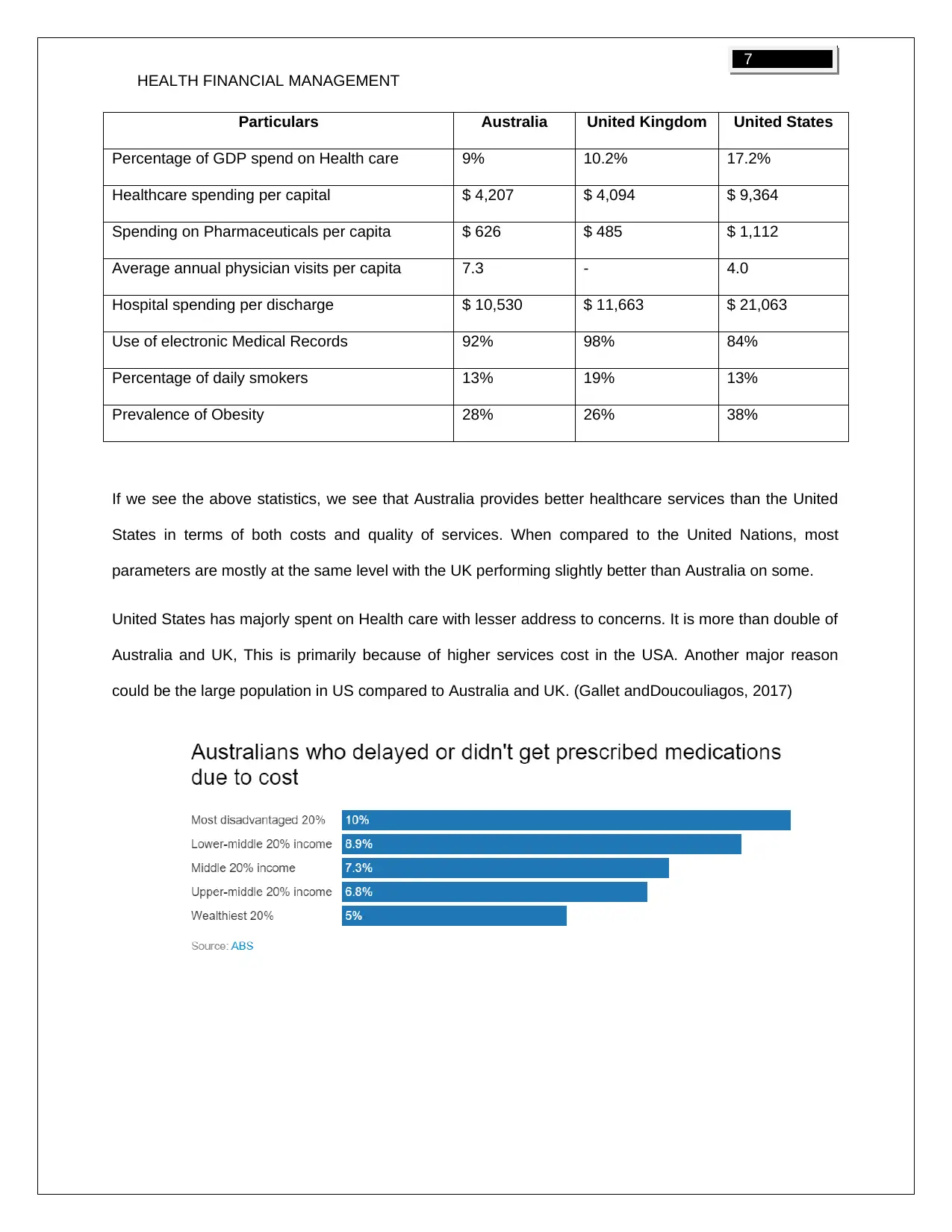
7
HEALTH FINANCIAL MANAGEMENT
Particulars Australia United Kingdom United States
Percentage of GDP spend on Health care 9% 10.2% 17.2%
Healthcare spending per capital $ 4,207 $ 4,094 $ 9,364
Spending on Pharmaceuticals per capita $ 626 $ 485 $ 1,112
Average annual physician visits per capita 7.3 - 4.0
Hospital spending per discharge $ 10,530 $ 11,663 $ 21,063
Use of electronic Medical Records 92% 98% 84%
Percentage of daily smokers 13% 19% 13%
Prevalence of Obesity 28% 26% 38%
If we see the above statistics, we see that Australia provides better healthcare services than the United
States in terms of both costs and quality of services. When compared to the United Nations, most
parameters are mostly at the same level with the UK performing slightly better than Australia on some.
United States has majorly spent on Health care with lesser address to concerns. It is more than double of
Australia and UK, This is primarily because of higher services cost in the USA. Another major reason
could be the large population in US compared to Australia and UK. (Gallet andDoucouliagos, 2017)
HEALTH FINANCIAL MANAGEMENT
Particulars Australia United Kingdom United States
Percentage of GDP spend on Health care 9% 10.2% 17.2%
Healthcare spending per capital $ 4,207 $ 4,094 $ 9,364
Spending on Pharmaceuticals per capita $ 626 $ 485 $ 1,112
Average annual physician visits per capita 7.3 - 4.0
Hospital spending per discharge $ 10,530 $ 11,663 $ 21,063
Use of electronic Medical Records 92% 98% 84%
Percentage of daily smokers 13% 19% 13%
Prevalence of Obesity 28% 26% 38%
If we see the above statistics, we see that Australia provides better healthcare services than the United
States in terms of both costs and quality of services. When compared to the United Nations, most
parameters are mostly at the same level with the UK performing slightly better than Australia on some.
United States has majorly spent on Health care with lesser address to concerns. It is more than double of
Australia and UK, This is primarily because of higher services cost in the USA. Another major reason
could be the large population in US compared to Australia and UK. (Gallet andDoucouliagos, 2017)
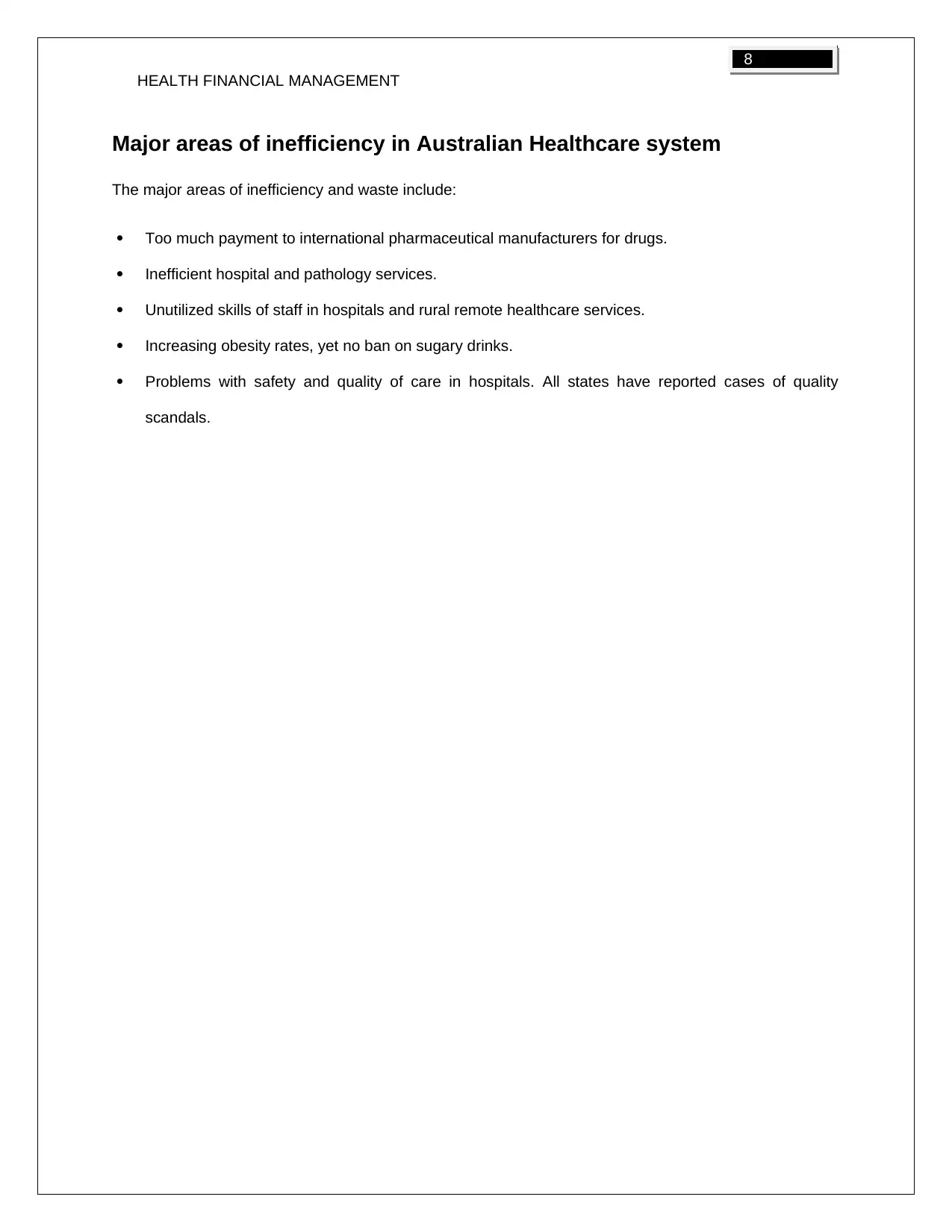
8
HEALTH FINANCIAL MANAGEMENT
Major areas of inefficiency in Australian Healthcare system
The major areas of inefficiency and waste include:
Too much payment to international pharmaceutical manufacturers for drugs.
Inefficient hospital and pathology services.
Unutilized skills of staff in hospitals and rural remote healthcare services.
Increasing obesity rates, yet no ban on sugary drinks.
Problems with safety and quality of care in hospitals. All states have reported cases of quality
scandals.
HEALTH FINANCIAL MANAGEMENT
Major areas of inefficiency in Australian Healthcare system
The major areas of inefficiency and waste include:
Too much payment to international pharmaceutical manufacturers for drugs.
Inefficient hospital and pathology services.
Unutilized skills of staff in hospitals and rural remote healthcare services.
Increasing obesity rates, yet no ban on sugary drinks.
Problems with safety and quality of care in hospitals. All states have reported cases of quality
scandals.
⊘ This is a preview!⊘
Do you want full access?
Subscribe today to unlock all pages.

Trusted by 1+ million students worldwide
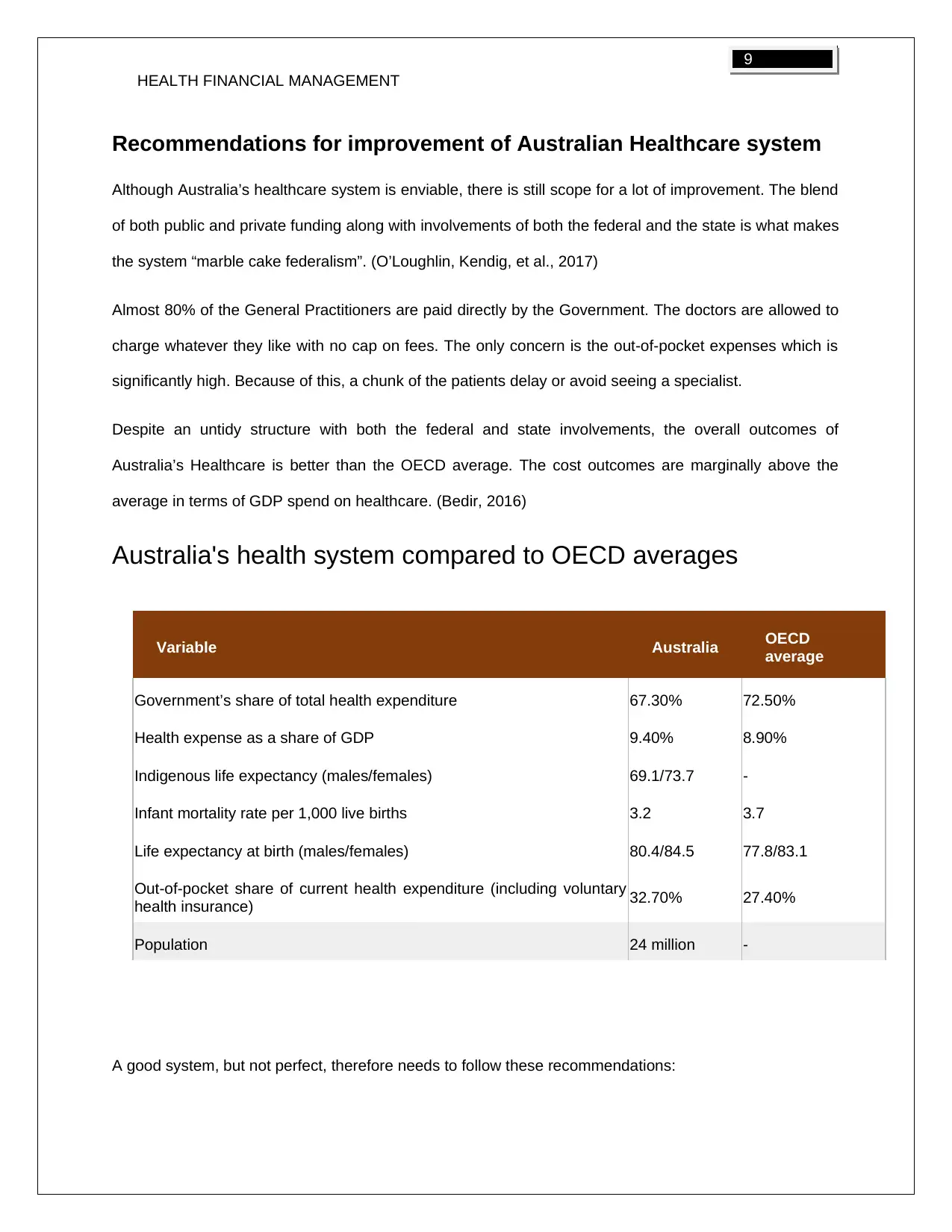
9
HEALTH FINANCIAL MANAGEMENT
Recommendations for improvement of Australian Healthcare system
Although Australia’s healthcare system is enviable, there is still scope for a lot of improvement. The blend
of both public and private funding along with involvements of both the federal and the state is what makes
the system “marble cake federalism”. (O’Loughlin, Kendig, et al., 2017)
Almost 80% of the General Practitioners are paid directly by the Government. The doctors are allowed to
charge whatever they like with no cap on fees. The only concern is the out-of-pocket expenses which is
significantly high. Because of this, a chunk of the patients delay or avoid seeing a specialist.
Despite an untidy structure with both the federal and state involvements, the overall outcomes of
Australia’s Healthcare is better than the OECD average. The cost outcomes are marginally above the
average in terms of GDP spend on healthcare. (Bedir, 2016)
Australia's health system compared to OECD averages
Variable Australia OECD
average
Government’s share of total health expenditure 67.30% 72.50%
Health expense as a share of GDP 9.40% 8.90%
Indigenous life expectancy (males/females) 69.1/73.7 -
Infant mortality rate per 1,000 live births 3.2 3.7
Life expectancy at birth (males/females) 80.4/84.5 77.8/83.1
Out-of-pocket share of current health expenditure (including voluntary
health insurance) 32.70% 27.40%
Population 24 million -
A good system, but not perfect, therefore needs to follow these recommendations:
HEALTH FINANCIAL MANAGEMENT
Recommendations for improvement of Australian Healthcare system
Although Australia’s healthcare system is enviable, there is still scope for a lot of improvement. The blend
of both public and private funding along with involvements of both the federal and the state is what makes
the system “marble cake federalism”. (O’Loughlin, Kendig, et al., 2017)
Almost 80% of the General Practitioners are paid directly by the Government. The doctors are allowed to
charge whatever they like with no cap on fees. The only concern is the out-of-pocket expenses which is
significantly high. Because of this, a chunk of the patients delay or avoid seeing a specialist.
Despite an untidy structure with both the federal and state involvements, the overall outcomes of
Australia’s Healthcare is better than the OECD average. The cost outcomes are marginally above the
average in terms of GDP spend on healthcare. (Bedir, 2016)
Australia's health system compared to OECD averages
Variable Australia OECD
average
Government’s share of total health expenditure 67.30% 72.50%
Health expense as a share of GDP 9.40% 8.90%
Indigenous life expectancy (males/females) 69.1/73.7 -
Infant mortality rate per 1,000 live births 3.2 3.7
Life expectancy at birth (males/females) 80.4/84.5 77.8/83.1
Out-of-pocket share of current health expenditure (including voluntary
health insurance) 32.70% 27.40%
Population 24 million -
A good system, but not perfect, therefore needs to follow these recommendations:
Paraphrase This Document
Need a fresh take? Get an instant paraphrase of this document with our AI Paraphraser
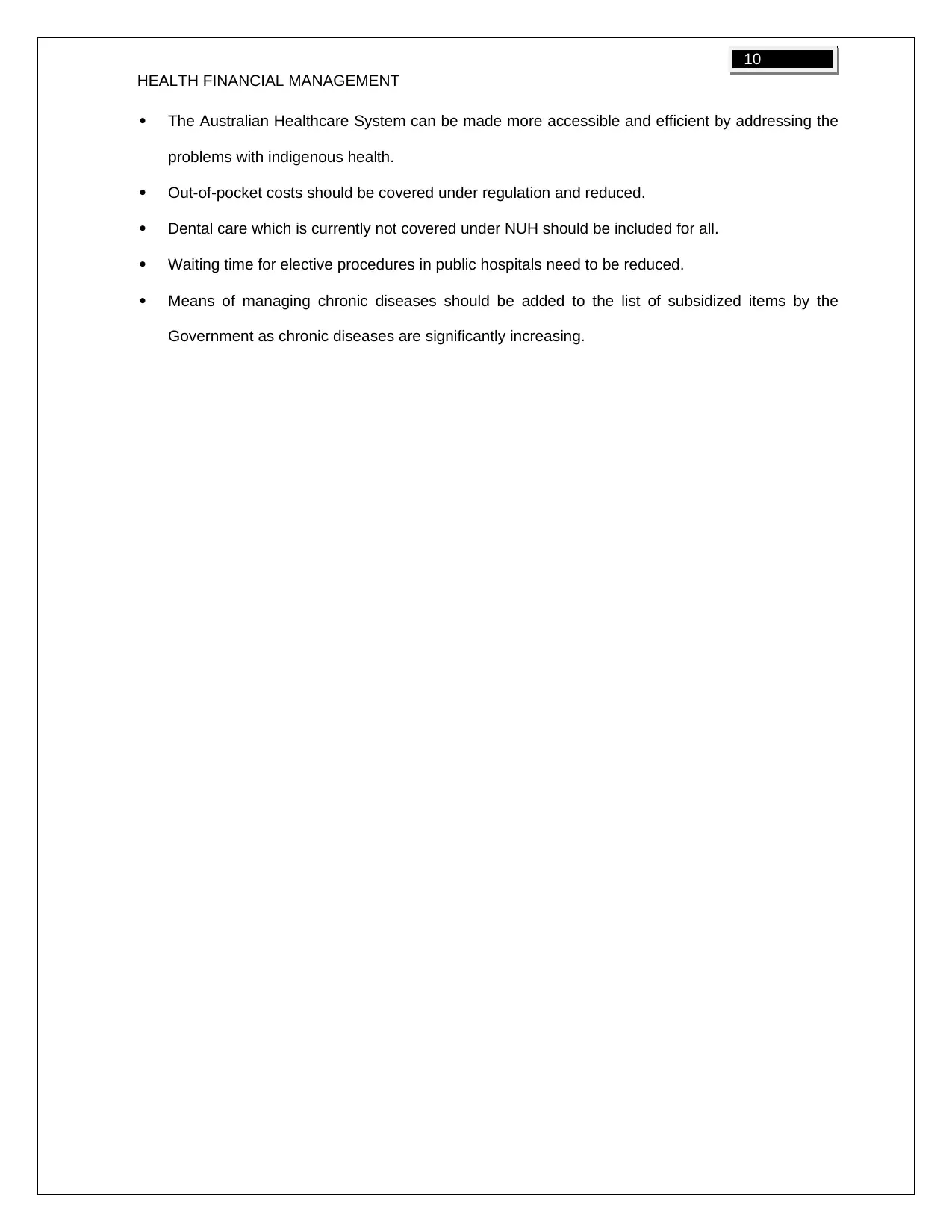
10
HEALTH FINANCIAL MANAGEMENT
The Australian Healthcare System can be made more accessible and efficient by addressing the
problems with indigenous health.
Out-of-pocket costs should be covered under regulation and reduced.
Dental care which is currently not covered under NUH should be included for all.
Waiting time for elective procedures in public hospitals need to be reduced.
Means of managing chronic diseases should be added to the list of subsidized items by the
Government as chronic diseases are significantly increasing.
HEALTH FINANCIAL MANAGEMENT
The Australian Healthcare System can be made more accessible and efficient by addressing the
problems with indigenous health.
Out-of-pocket costs should be covered under regulation and reduced.
Dental care which is currently not covered under NUH should be included for all.
Waiting time for elective procedures in public hospitals need to be reduced.
Means of managing chronic diseases should be added to the list of subsidized items by the
Government as chronic diseases are significantly increasing.

11
HEALTH FINANCIAL MANAGEMENT
References
Bedir, S. (2016). Healthcare expenditure and economic growth in developing countries. Advances in
Economics and Business, 4(2), 76-86.
Carey, G., Malbon, E., Carey, N., Joyce, A., Crammond, B., & Carey, A. (2015). Systems science and
systems thinking for public health: a systematic review of the field. BMJ open, 5(12), e009002.
Gallet, C. A., &Doucouliagos, H. (2017). The impact of healthcare spending on health outcomes: A meta-
regression analysis. Social Science & Medicine, 179, 9-17.
Gearhart, R. (2016). The robustness of cross-country healthcare rankings among homogeneous OECD
countries. Journal of applied economics, 19(1), 113-143.
Hadad, S., Hadad, Y., & Simon-Tuval, T. (2013). Determinants of healthcare system’s efficiency in OECD
countries. The European journal of health economics, 14(2), 253-265.
Obama, B. (2016). United States health care reform: progress to date and next steps. Jama, 316(5), 525-
532.
O’Loughlin, K., Kendig, H., & Browning, C. (2017). Challenges and opportunities for an ageing Australia.
In Ageing in Australia (pp. 1-10). Springer, New York, NY.
Önen, Z., &Sayın, S. (2018). Evaluating healthcare system efficiency of OECD countries: A DEA-based
study. In Operations research applications in health care management (pp. 141-158). Springer,
Cham.
Weeramanthri, T. S., & Bailie, R. S. (2015). Grand challenges in public health policy. Frontiers in public
health, 3, 29.
Wubulihasimu, P., Brouwer, W., & van Baal, P. (2016). The impact of hospital payment schemes on
healthcare and mortality: evidence from hospital payment reforms in OECD countries. Health
economics, 25(8), 1005-1019.
HEALTH FINANCIAL MANAGEMENT
References
Bedir, S. (2016). Healthcare expenditure and economic growth in developing countries. Advances in
Economics and Business, 4(2), 76-86.
Carey, G., Malbon, E., Carey, N., Joyce, A., Crammond, B., & Carey, A. (2015). Systems science and
systems thinking for public health: a systematic review of the field. BMJ open, 5(12), e009002.
Gallet, C. A., &Doucouliagos, H. (2017). The impact of healthcare spending on health outcomes: A meta-
regression analysis. Social Science & Medicine, 179, 9-17.
Gearhart, R. (2016). The robustness of cross-country healthcare rankings among homogeneous OECD
countries. Journal of applied economics, 19(1), 113-143.
Hadad, S., Hadad, Y., & Simon-Tuval, T. (2013). Determinants of healthcare system’s efficiency in OECD
countries. The European journal of health economics, 14(2), 253-265.
Obama, B. (2016). United States health care reform: progress to date and next steps. Jama, 316(5), 525-
532.
O’Loughlin, K., Kendig, H., & Browning, C. (2017). Challenges and opportunities for an ageing Australia.
In Ageing in Australia (pp. 1-10). Springer, New York, NY.
Önen, Z., &Sayın, S. (2018). Evaluating healthcare system efficiency of OECD countries: A DEA-based
study. In Operations research applications in health care management (pp. 141-158). Springer,
Cham.
Weeramanthri, T. S., & Bailie, R. S. (2015). Grand challenges in public health policy. Frontiers in public
health, 3, 29.
Wubulihasimu, P., Brouwer, W., & van Baal, P. (2016). The impact of hospital payment schemes on
healthcare and mortality: evidence from hospital payment reforms in OECD countries. Health
economics, 25(8), 1005-1019.
⊘ This is a preview!⊘
Do you want full access?
Subscribe today to unlock all pages.

Trusted by 1+ million students worldwide
1 out of 12
Related Documents
Your All-in-One AI-Powered Toolkit for Academic Success.
+13062052269
info@desklib.com
Available 24*7 on WhatsApp / Email
![[object Object]](/_next/static/media/star-bottom.7253800d.svg)
Unlock your academic potential
Copyright © 2020–2025 A2Z Services. All Rights Reserved. Developed and managed by ZUCOL.





